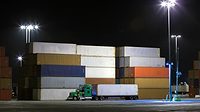Nearly 75 percent of companies experienced at least one supply chain disruption in 2012, with an average of five, according to the 4th Annual Supply Chain Resilience 2012 Survey. Overall, 1,200 causes of disruption were reported, and 301 of them were designated as high-impact.
The report, which surveyed more than 530 organizations from more than 65 countries, also found that IT outages – including telecom disruptions – have increased 11 percentage points from 2011 to be one of the top sources of disruption, with 52 percent of participants affected to some or a high degree. Other severe events include adverse weather (48 percent), disruption in the financial services sector (41 percent), failure in service provision by an outsourcer (35 percent), cyber threats (16 percent) and intellectual property violations (11 percent).
The consequences of these disruptions are gaining impact as well – all 14 potential areas of impact showed an increased level of responses in the survey. Loss of productivity is still the primary consequence, with 59 percent checking this in 2012 compared to 49 percent in 2011. The increased cost of working, loss of revenues and customer complaints all increased from their 2011 levels, and product release delay jumped from 17 percent in 2011 to 26 percent in 2012.
Longer-term impacts are also being experienced more frequently – damage to brand reputation increased from 17 percent to 24 percent in the 2012 survey.
The economic consequences are growing as well. One in five organizations had suffered a single loss event of more than €1M in the past 12 months. Only 17 percent of respondents reported similar losses in 2011.
However, despite all of the disruptions, only 58 percent of responding organizations stated that they had business continuity arrangements in place to deal with supply chain disruption. Twenty-five percent said they definitely did not, and 17 percent didn’t know. But 77 percent of those with a business continuity plan asked their key suppliers whether or not they had business continuity arrangements for their own needs.
Manufacturing, especially, experienced high levels of disruptions relative to others (85 percent experienced at least one disruption) and a different range of disruptive events. However, the sector stands out even more for the lack of in-house supply chain continuity programs at just 38 percent.
Top challenges include a lack of buy-in from management (21 percent) and resource or budget availability (20 percent).
Top 10 Challenges to Achieving Assurance in Supply Chain Resilience
· 21% -- Lack of buy-in from management and/or procurement as evidence in strategy or policy
· 20% -- Resource and budget availability
· 16% -- Complexity/structure of the organization
· 10% -- Lack of information/cooperation from supply chain partners e.g. “confidentiality”
· 10% -- Lack of options: limited by physical location, monopoly providers, specialist providers
· 6% -- Trust in suppliers to do what they promise
· 4% -- Lack of awareness of the impact of supply chain disruption
· 4% -- Competency or education: internal and among supply chain partners
· 3% -- Lack of focus e.g. too many suppliers
· 2% -- Getting business continuity requirements into legacy contracts
Information from Supply Chain Resilience Survey 2012



